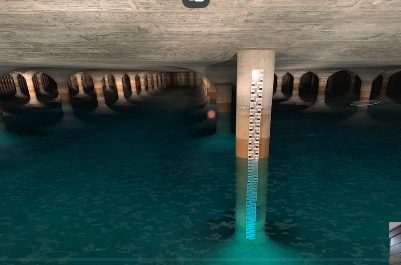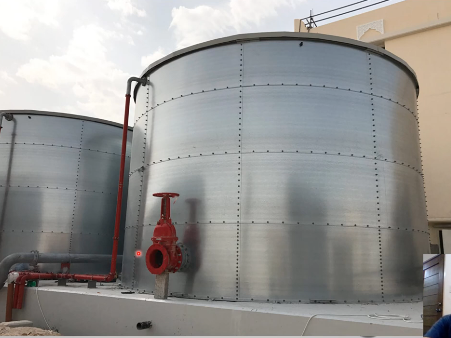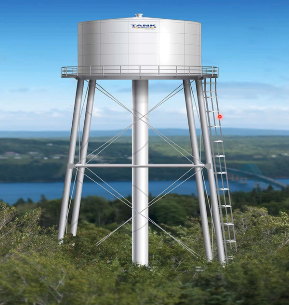Lecture 3 EU2: Potable Water Storage
1/18
There's no tags or description
Looks like no tags are added yet.
Name | Mastery | Learn | Test | Matching | Spaced |
|---|
No study sessions yet.
19 Terms
Potable Water Storage
_____
_____
_____
Underground Water Reservoir
Water Tank - ground level
Elevated Water tank

Underground Water Reservoir
mostly rectangular prism shape
Has an inflow and outflow
Sump Pit - makes pumping water out the reservoir easier
if may maintenance iddrain yung
water para linisan.
After lagay sa sump pit,
tsaka lalagyan ng submersible pump para
maubos yung tubig
Pataas - mababa pressure (upper part yung inflow)
Pababa - mataas pressure (Lower part yung outflow)
May sensor para hindi magoverflow, matic
magsasara yung valve

Ground Level Water Tank
Cylinder shaped.
Mas madaling linisin compared sa ibang potable water storage
Ginagamit si cylinder type, like sa Clark
Water, sa Prime Water sa Orani, sa
Waltermart sa Balanga
Inflow sa taas fini-fill up. May sensor uli to
avoid overflow
Outflow, sa baba pa rin kasi triangular pa rin
yung presure
Sump pit uli sa baba, may slope
Madalang yung general cleaning ng mga
water tank kasi matagal yung process. 6hr
disinfection, 24 hours waiting. If ganon
katagal mawawalan ng service, malaki
mawawalang money.

Elevated Water Tank
Cylinder shaped though may legs.
Sa Bakal gawa, back then concrete is the leading material
Pressure Diagram is Triangular pa rin
Why use Water Tanks/Reservoir?
_____
_____
_____
_____
lessen operation cost in pumps
pressure maintenance The Larger the tank, the more stable pressure to the system
Emergency storage during power outage, unexpected shutdowns
Lessen energy consumption (peak energy usage)
Underground Reservoir - Pros
Least susceptible to temperature
Aesthetics
Underground Reservoir - Cons
Land Availability
Construction Duration
Ground Level Tank - Pros
Seismic Considerations
Easy to Construct
Cheapest out of the three potable water storage
Ground Level Tank - Cons
Aesthetics
susceptible to temperature
Elevated Water Tank - Pros
Land Availability
Can construct at any terrain
Elevated Water Tank - Cons
Expensive
Aesthetic
Susceptible to Temperature
Water Quality Problems
_____
_____
_____
Chemical Problems
Microbiological Problems
Physical Problems
Loss Of Disinfectant Residual
The Loss of Dissinfectant residual is a chemical process resulting in the decrease of the secondary disinfectant generally either free chlorine or total chlorine
It is probably the most common water-quality concern and is a function of time and rate of disinfectant decay (loss)
The rate of loss can be affected by
microbiological activity,
temperature,
nitrification
exposure to ultraviolet light (sun)
amount and type of disinfectant demanding compounds present such as organic and inorganic compounds/
Chemical Problems
Formation of Disinfection by Products (DBP)
Disinfection by-products (DBP) are formed when the disinfectant used reacts chemically with the organic material in the treated water.
Chemical Problems
Development of Taete and Odor
Happens particularly on new water tanks
The Sources of tastes and odors in the distribution system, including emission from construction materials, external contaminants, biological activity, disinfectant residuals, and DBP
Chemical Problems
Microbiological Problems
Bacterial Regrowth
Bacterial and regrowth and biofilms are typically more of a problem in piping systems in a storage facilities because of the greater surface-area-to water volume ratio when compared to storage facilities.
Worms and Insect
It is possible for worms or insects to enter the distribution system through finished water-storage facilities, cross connection, dead-ends, or from stirred-up sediment in the bottom of distribution mains
Microbiological Problems
Sediment Build up
Particulates may be introduced in the distribution system if the water treatment facility is not working properly.
Sediment frequently accumulates in the storage tanks where the velocities are minimal
Physical Problems
Entry of Contaminants
Open reservoirs or storage facilities potentially are subject to contamination from bird droppings and other animal extrement that have the potential to transmit the disease-causing organisms to the finished water.
Physical Problems